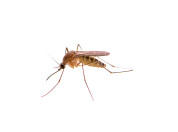Droevendaalsesteeg 10
6708 PB Wageningen
The Netherlands
My research focusses on vector borne diseases in bird populations to investigate which birds are impacted by these diseases and detect the underlying mechanism of these effects. My project includes an in-depth study on Common blackbirds.
I started in 2016 with the study Applied Biology at the HAS Hogeschool, which was followed by the Master Biology at the Radboud University in Nijmegen. During my masters I worked on modelling population dynamics and effects of environmental conditions on the populations of Oystercatchers, Kentish and Ringed plovers.
Mosquito-borne arboviruses, including Usutu virus (USUV) and West Nile virus (WNV), are emerging threats in Europe, with changes in climate, land use shifts, and increasing global connectivity influencing their dynamics. Understanding how these viruses emerge and establish in new regions is critical for mitigating risks and improving public and wildlife health preparedness. Here, we present a seven-year study (2016–2022, inclusive) documenting the emergence and spread of USUV and WNV in the Netherlands. We established a nationwide sampling framework integrating live birds sampling by volunteer ringers, dead birds referrals by citizen scientists and zoos, and mosquito trapping. Samples were analyzed using molecular, genomic, and serological methods. USUV was first detected in the Netherlands in 2016, caused major outbreaks in birds until 2018 and resurged in 2022. The dominant, enzootic lineage, Africa 3, co-circulated with sporadic introductions of lineage Europe 3. The first localized WNV lineage 2 outbreak occurred in live birds and mosquitoes in 2020, followed by a detection in a bird in 2022 and serological evidence of continued circulation, suggesting WNV is in an early stage of establishment. Our findings were crucial in detecting a human WNV outbreak, underscoring the value of integrated wildlife studies in detecting emerging threats to public health.
Usutu virus is a zoonotic arbovirus that causes massive mortality in blackbirds. Using a unique longitudinal dataset on the kinetics of virus-specific antibodies in naturally infected wild blackbirds (Turdus merula), we found that individual birds may remain seropositive for >1 year and that reinfection can occur despite low-level virus neutralizing antibodies.
To understand the consequences of anthropogenic and environmental changes for wildlife populations, it is important to study how individuals differ in their sensitivity to environmental change and whether this depends on individual characteristics. An individual's reproductive performance may provide an integrative, unidimensional proxy of an individual's characteristics. In this study, we define an individual's characteristics by three such reproductive states, namely successful, failed and non-breeders in the previous year. We used a 16-year dataset of individually marked breeding Eurasian Oystercatchers Haematopus ostralegus to examine the interannual fluctuations in reproductive success and survival among breeding states, and their state-dependent sensitivity to environmental conditions. Environmental conditions included available biomass of the main prey species of breeding Oystercatchers (Ragworm, Baltic Tellin and Lugworm), tidal height, which reflects one of the main causes of nest loss (flooding), and conditions that may impact the energetic requirements during incubation, such as temperature. We also included environmental variables measured in winter, including available biomass of the main winter prey species (Blue Mussel and Common Cockle) along with factors that may affect food availability and energetic requirements for homeostasis, namely bivalve weight loss, windchill, winter severity and precipitation. Breeding birds that were successful the previous year had higher survival and were more likely to remain successful, in comparison with failed or non-breeders. The effects of environmental conditions acted in the same direction on reproductive success but had opposite effects on survival among the three breeding states, especially for windchill and Blue Mussel biomass. The contrasting state-dependent effects of the environment on survival thus averaged out when examining consequences for lifetime reproductive nest success (LRnS); instead, LRnS was largely influenced by environmental conditions acting upon reproduction. Our study indicates that an individual's previous breeding state provides an integrative measure of heterogeneity in individuals' sensitivity of reproduction and survival to environmental change. Incorporating previous breeding state as a source of individual heterogeneity in population modelling may improve predictions of future population dynamics in a rapidly changing world.

